Noise analysis of eVTOLs aircraft

The September issue of the Royal Aeronautical Society’s Aerospace journal publishes new research into the impact of noise pollution on future transport networks using urban air mobility, and how it can be mitigated to gain public acceptance.
In 2021, the European Aviation Safety Agency (EASA) published the results of a survey assessing public acceptability of future aerial mobility vehicles (AAM) in EU urban mobility systems (https://www.easa.europa.eu/domains/urban-air-mobility-uam). Based on responses from 3,690 citizens from six European cities, the survey identified noise as one of the main issues for social acceptance of AAM. Legislation related to vertical take-off and landing point infrastructure and route planning, as well as electric aircraft design, is expected to be highly influenced by society’s perception of noise.
In September, the Royal Aeronautical Society (RAeS) hosted the European Rotorcraft Forum online conference to discuss all aspects of helicopter design, technology and operations. In addition to presentations from leading rotorcraft manufacturers and operators, the three-day event included more than 100 technical presentations, some of which addressed public perception of rotorcraft noise.
Noise and buildings

The emergence of eVTOL transportation systems will increase noise levels in cities. (Volocopter)
These include a paper by G Gilbertini, S Rezzonico, M Rossetti and A Zanotti from the Department of Aerospace Science and Technology at the Politecnico di Milano, which examines the noise problem of helicopters in urban flight. This is a hot topic, as the introduction of future eVTOL urban transport systems will increase the number of rotary-wing aircraft flying over residential areas. Helicopters are noisiest when they fly close to buildings, such as when approaching rooftop helipads. The issue of helicopter noise, while not new, has not been systematically studied.
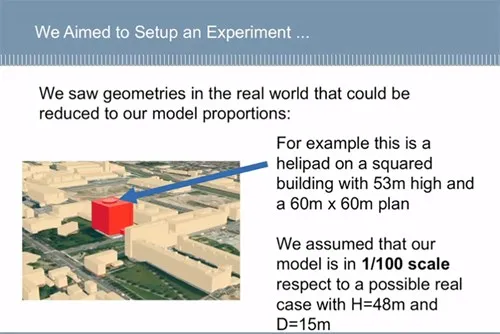
Italian rotorcraft noise simulation is modeled after real buildings in Milan. (Politecnico di Milano)
Italian researchers conducted experiments using a 15cm two-bladed rotor operating next to a 48cm high model building, which is 1/100 scale and is equivalent to a similarly shaped 53m high building in Milan that has a helipad on its roof. The model used to simulate the building was made by Germany’s DLR as a test bed for the MiTraPor project, which studies the aerodynamics of airdrops of military cargo.
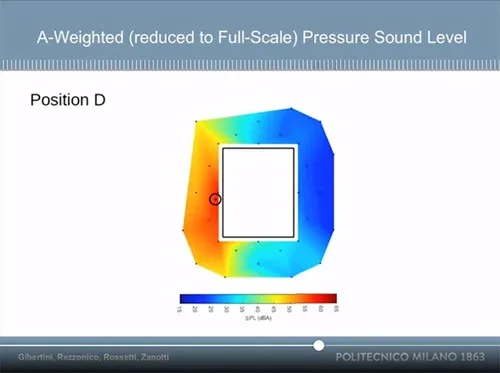
At their closest point, the sound of a rotor close to a building could affect a large area. (Politecnico di Milano)
The sound tests were conducted in an anechoic chamber and used sensors on the ground to measure different sound levels from a rotor model located at different points on a straight approach path towards the top of a building. Not surprisingly, the noise level was higher at the front of the building facing the rotor and increased as the rotor got closer. When the rotor was very close, the noise level was equally high across the entire front of the building. The measured sound pressure spectrum consisted of a combination of the noise from the rotor and the motor. Reflections from the walls also amplified the noise when the rotor was close to the building.
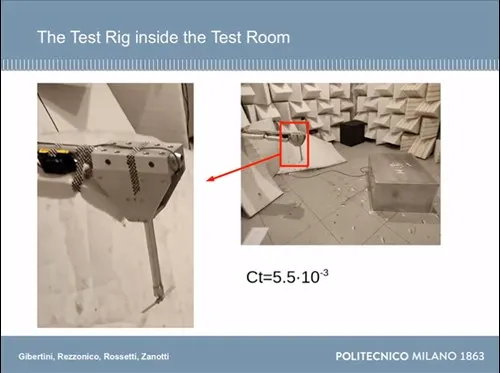
Model rotor and building test bench. (Politecnico di Milano)
The conclusion of the experiment was that the sound levels of helicopters can vary depending on the approach path as well as different building geometries. The Politecnico di Milano will study these two factors in future tests.
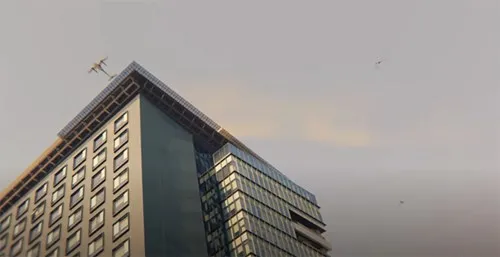
How annoying is the noise of eVTOLs flying over cities? (Uber Elevator)
Noise from rotorcraft was also mentioned during the Arup SoundLab keynote, which looked at using sound and visualisation to help understand disruptive technologies – specifically the introduction of vertical take-off and landing points as part of eVTOL future air mobility (AAM) into urban transport systems. Arup recently conducted a study for the European Union Aviation Safety Agency (EASA) to gain insight into how people react to the impacts of AAM noise. The study suggests that AAM aircraft may be more annoying than other modes of transport, which could have implications for planning and legislation of AAM noise.
Since AAM aircraft are not yet in service, the closest analogy is helicopters, which fly at lower altitudes than fixed-wing aircraft and operate closer to “noise-sensitive receptors.” In a literal sense, echoing the results of the Italian study, Arup concluded that the sound emitted by rotorcraft operating in an urban environment will also be transmitted with multiple reflections from buildings and will also be affected by the complexity of the urban microclimate.
For the past decade, Arup SoundLab has been conducting what it describes as “sonification and visualization of infrastructure plans for stakeholder and community engagement.” These activities include public demonstrations where people are able to experience the sounds and sights of a future design project in virtual reality before actually building the project, alleviating people’s concerns so they can make an informed decision about whether to approve the plan. VR demonstrations have included simulations of new airport terminals, high-speed rail links, road construction, and most recently, AAM aircraft and vertical take-off and landing sites.
Through internally funded research, Arup developed a generic acoustic model of the AAM aircraft. Once the operating conditions such as trajectory, climb rate, cruise speed and receiver position were defined, sound propagation was modelled using NASA Auralisation Framework (NAF) software and sonified using Arup SoundLab. This allows the listener to hear the sound of an aircraft that may not yet exist and can be an effective tool for optimising the aircraft’s noise signature.
Synthetic electric aircraft sound effects were first demonstrated at the first Global Urban Aviation Summit (GUAS) in Farnborough in September 2019. In preparation for AAM’s operations in Los Angeles in 2020, a series of sounds were created featuring the passing sounds of helicopters, generic AAM aircraft and generic drones using the same flight paths. In addition, Arup used a web-based interface that allows users to plot different flight paths for different types of aircraft and calculate noise contours for each flight path.
Since the noise signature of AAM aircraft is different from that of conventional rotorcraft, a pilot study was conducted to gain a preliminary understanding of people’s reactions to the noise signature of AAM aircraft. The study aimed to: (1) investigate whether sound demonstrations are an appropriate way to engage and understand people’s reactions to UAM sounds; (2) test and develop methods for conducting a larger study; and (3) gain a preliminary understanding of people’s perceptions of UAM sounds.
Sound simulation
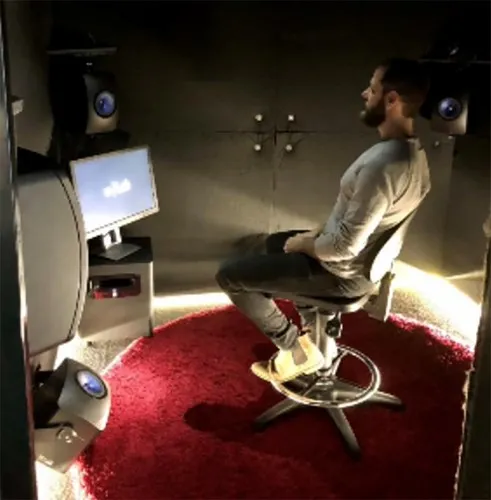
The m|Lab. (Arup)
Due to travel restrictions during the COVID-19 pandemic, the research was conducted using a mobile facility (m|Lab) installed at Arup’s Amsterdam office. m|Lab uses 3D two-tone sound, focused at the listener’s head height, emitted through a series of speakers at floor, head height and overhead, as well as a woofer. The walls are treated with sound-absorbing material.
The sounds were calibrated to 80dB Amax, Class F, using jets, helicopters, buses, motorcycles, large and small multi-copter drones, recorded air taxis, and synthetic air taxis. In addition, the air taxi sounds were reproduced at two lower sound levels (60 and 70dB Amax, F). Listeners were asked to rank each sound based on “how much the sound bothered, annoyed, or disturbed them” on a scale of 0 (not at all) to 10 (very bothersome). They were also asked to provide comments on which aspects of the sound influenced their rating. A total of 20 listeners participated in the trial, which Arup noted was too small a sample of data to produce statistically reliable results, but paved the way for larger surveys.
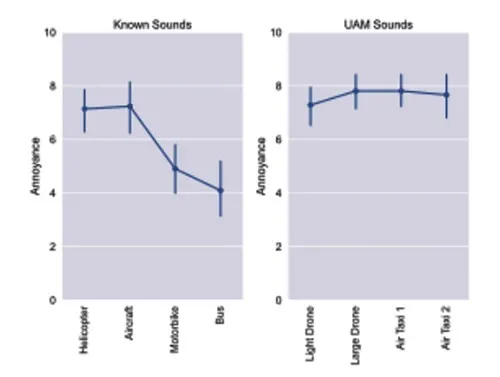
Drones and air taxis scored highest for annoyance. (Arup)
When comparing sounds of similar levels, participants reported generally higher annoyance levels for unfamiliar sounds. The difference was particularly significant when comparing AAM sounds to road transport sound sources. This may suggest that as citizens become familiar with the sounds of AAM aircraft, annoyance levels will decrease.
The average annoyance for the air taxi and large drone was the highest, while the synthetic air taxi had an average annoyance of 80dBLAmax and an F-score only slightly lower. As expected, annoyance increased with increasing sound level.
For most AAM vehicles, there is usually a clear tonal component around 3kHz, corresponding to the frequency that humans are most sensitive to. The tones were more pronounced in the test air taxis than in the drones.
Forward-looking planning
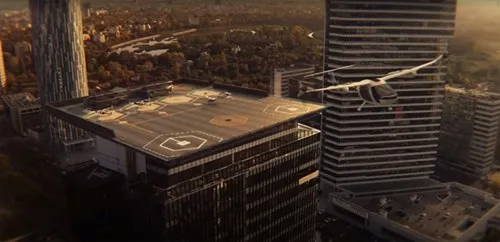
These studies will help mitigate noise levels in future cities. (Uber Elevate)
As with the Italian study, Arup’s research is still in its initial stages, and more work can be done to develop ways to use sound to facilitate dialogue and understanding of environmental impacts and social responses to noise. More work can be done to simulate more specific UAM designs for urban infrastructure, as well as to conduct larger public surveys. The findings could benefit both UAM designers and operators in reducing the noise impact of their vehicles, and urban planners and legislators who are mandating the introduction of urban transportation infrastructure.
Excerpted from the September issue of Aerospace, a journal of the Royal Aeronautical Society
Translation: Zheng Yajing





